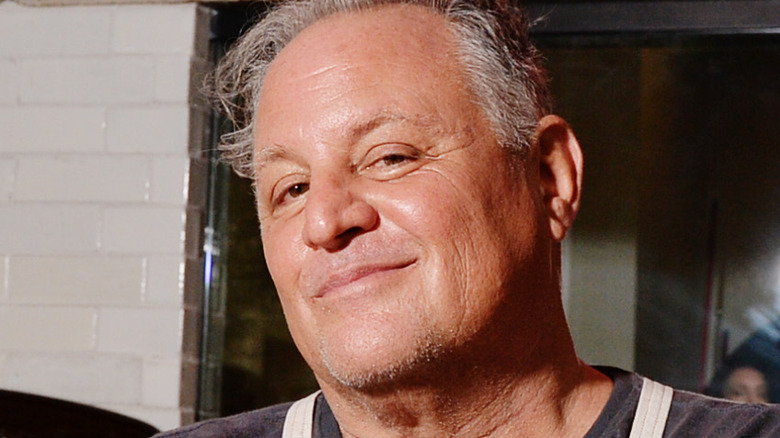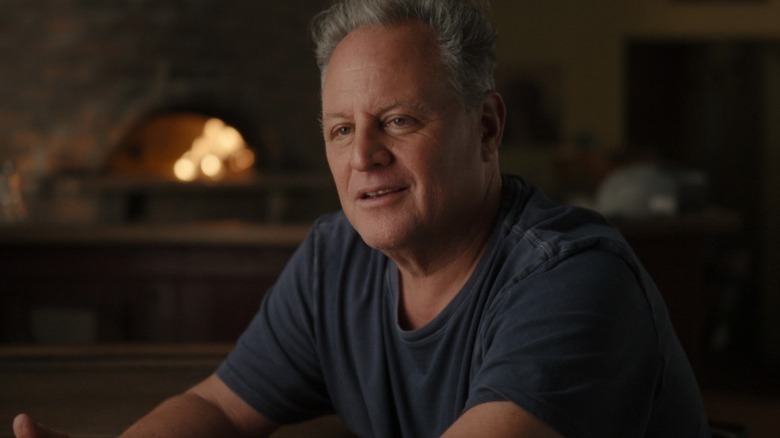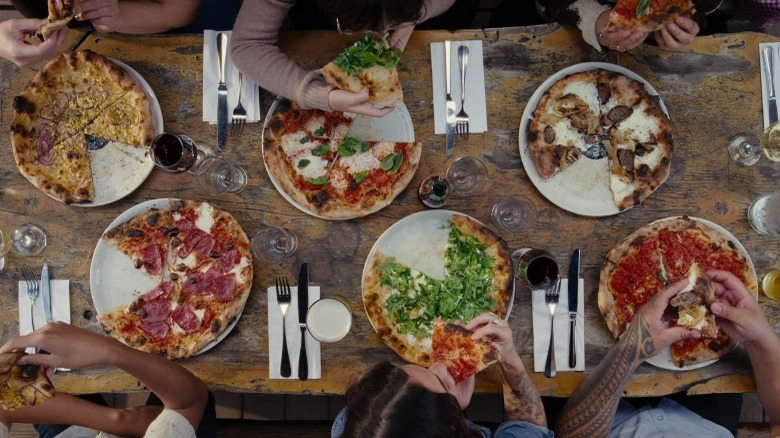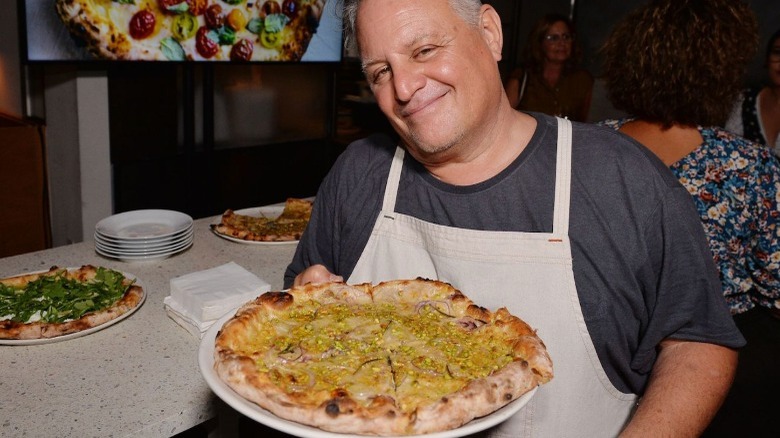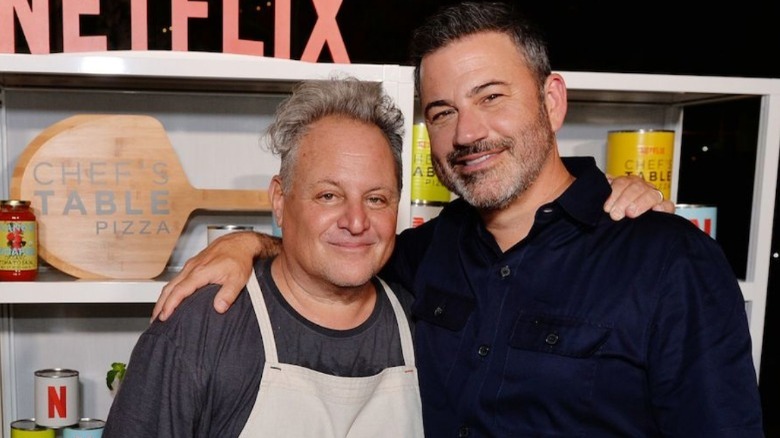Chris Bianco Talks Life, Love, And Pizza - Exclusive Interview
Since opening Pizzeria Bianco, Chris Bianco has risen to fame as one of the best pizza chefs in the country. Now, Bianco has five different restaurants in Phoenix, along with the recently opened Pizzeria Bianco in Downtown Los Angeles. His expertise is highlighted in Episode 1 of Netflix's new "Chef's Table: Pizza," where viewers are given an inside look at Bianco's love for pizza and his love for life.
Rather than simply scratching the surface, Bianco is a profound storyteller who loves to explore the more meaningful side of life, giving his food an entirely new level of love. Whether he is in the kitchen firing up a margherita pie or chatting with customers over a glass of wine, Bianco allows his passion for people and pizza to shine through in everything that he does. During an exclusive interview with Tasting Table, Chris Bianco shared everything from his not-so-secret sauce tips to thoughtful advice that goes beyond cooking in the kitchen.
The experience of Chef's Table
What was one of your favorite parts about filming for the series?
It was a crazy time. It was about a year ago now — still in the grips of the pandemic. You spend a little over two weeks with strangers, and all of a sudden they become like family.
I always say I'm in the relationship business. Everything is based on the relationships I have with my family, my friends, the people that come in our restaurants, and former strangers. It was an amazing group of people that were extremely talented. They were also very forgiving. They were very good at putting you in a place that you were comfortable. For better or for worse, they were looking for who you were, more than what they wanted you to be. In my professional career, I haven't had a greater honor [than] to be part of this, for sure.
Formative influences
During the episode, you mentioned your first trip to Italy as a kid. How formative do you think that trip was in regard to your future as a chef?
We weren't a family that traveled a lot. My dad and my mom worked the whole time, like most families. But for any young chef, travel and interfacing with things that are beyond your block is what shapes us. Being a 13-year-old kid and going to Italy, and being from New York, I thought I knew what Italian food looks like and tastes like. In some cases, they do intertwine. But in a lot of cases, you see them at their source, and they're different. People look the same but different. All of a sudden you find, as a stranger ... You grow up in a neighborhood where you know everybody, and go to the same grocery store, and the same deli, and you go to pick up your parents' dry cleaning in the same place.
Then you're in a different place. In the best-case scenario, something great will find its way in. For me, it was on the food side of it. I talked about in the episode this bowl of peaches that I had in Rome for dessert. It was definitely life-changing because it was something not what I expected for dessert in a trattoria. I thought maybe you would get something like cassata — that's this Sicilian cake — or a cannoli, or whatever. I never had someone be so confident that they're going to serve you a f***ing perfect peach that was rinsed in cool water and dropped in a plate. But they had it.
I thought, "Holy s***, I never ate a piece of fruit like this before." [It was] fully illuminated or fully heightened of what it was and the source, and the way it was saying where it was from ... They were so proud of it. It made an imprint and taught me that it wasn't about what you made so much. It was about your ability to recognize what was already great and [if] you could serve it to its greatest and highest good. That has impacted me, along with other meals and experiences during that trip and many after, but it definitely made a huge impact on my life in that manner.
Pizza-making tips and tricks
Do you have any secret sauce tricks that you can share?
Sure. I have the secret sauce tips ... but there's definitely no secrets. That's the thing. You start with good things and you try not to screw them up. Look at it this way — cooking's a little bit like Jenga. Sometimes the most important ingredient is what you leave out. Maybe rethink what you feel something needs. Does a pizza need red sauce or green sauce or whatever sauce? Does it need it?
If you had some roasted broccoli rabe and sausage and garlic, maybe it needs a little scrape of lemon. You think about the cheese, or maybe even omit the cheese. That's really the secret to pizza — understanding what it needs more than what you want to give it.
What I mean by that is who are you cooking it for? Is it for you? Is it for an audience? Is it for a five-year-old? You're marrying the opportunity with the experience with the opportunity. In that manner, cooking's like architecture. The best architecture or the best cooking comes from people that have the ability to make something for the intended. You have certain needs in your home. You have certain needs at the table. Somebody making something for you, it's their ability to give you what you need. That's pretty cool.
As far as making a red sauce, I don't cook the sauce for a margherita, for instance. We use whole peeled organic tomatoes, our own brand. We hand crush them. We add a little bit of extra virgin olive oil, a little bruise of fresh basil leaves, and maybe the salt. Our tomatoes have a little bit of sea salt in them — possibly a turn of black pepper, and that's it. Leave that to sit for maybe 30 minutes before using, so that basil and the olive oil have a chance to activate the tomatoes that were already in balance and delicious. Then it'll continue to reduce or cook on the pizza itself.
What are some of the biggest mistakes you see home cooks make when making pizza?
Being overly critical of themselves. You learn things when you burn things. If you screw up five times in a row, don't give up, because you'll learn something in that failure.
A lot of times ... 800 degrees might not be the temperature, even though somebody said the best pizza cooks at 800 degrees, or you cook it for 90 seconds only. That all might be well, but not for you. It might not be what you want. A New York pizza? Well, that would be a lower temperature. That might be 650.
The first thing you want to do when you want to make pizza is find out what pizza you want to make. There's little nuances of each, whether it's flour varietal, hydration, leavening, salinity, fats, acids, or whatever, and you want to take all those into context.
If you're cooking from a memory, and you have a certain thing in your mind — what great pizza tastes like — you reverse engineer from that point. It's giving yourself the freedom of what you want. I'm like, "If you want it, or if it makes sense to you, who am I to judge?"
When making a pizza, everything matters
A lot of people think that the toppings are the most important part of a pizza, but do you think that it's in the dough?
It's everything. Everything matters. Let's say you had everything perfect. You got the most beautiful toppings at the farmer's. Your dough, your flour's freshly milled and organic, and from regenerative farmers. Everything's laid out. It's perfect. But you forgot to measure the salt, and you over- or under-salted it. That can throw everything off, in that foundation.
It's a slippery slope when you start identifying anything singular as the secret. You remove the secret and restart everything. I know everything matters, just like the best pasta in the world can be ruined if you don't salt the water for the pasta itself. You'll never be able to put that in balance from a topical salinity, from putting salt on top of the pasta. It needs to be cooked into the pasta.
All those things for pizza, you find out ... like, "Can I make great pizza with crappy flour?" Not in my opinion. Can you make things that taste good that are not good? In my opinion, yes. There's a lot of s**tty food that tastes pretty good if you put enough sugar or salt or whatever that is in the back part of our brain that makes us crave things or gets us addicted.
But what good food means to me is it's from a good source. I buy from good people. What I support matters. If I'm buying organic flour from Kevin Morse in Cairnspring or Central Milling, I know it will be great, or Hayden Flour Mills in Phoenix. I know sources. Whether it's a rumor or a tomato or a pizza, consider the source. Consider the source of that information.
If it doesn't make sense to you, then that's okay. I'm not wrong, you're not right, or vice versa. These are just opinions. The secret is to not be afraid to bring yourself in as your ultimate judge. There's so many things today. Who's rating pizza? Whether it's a 9.5 an 8.4 or a 2 or whatever — if someone's number six is your number one, who gives a s***? The more we can trust ourselves, the easier it all gets, and that's not just for pizza.
The story behind the Rosa pizza
How did you come up with the recipe for the Rosa pizza, and what makes it so special?
The long story short is that I was in Italy maybe 35 years ago, right after I moved out to Phoenix. I was in Liguria, and I had a pizza there. It was actually focaccia, but it was thin like a pizza. It had Grana Padano — a Parmesan-style cheese — and sesame seeds. That was all that was on it, except for olive oil. It was next to this little salumeria, this place that makes charcuterie and prosciutto and things. You could order these focaccias, these sparse, simple pizzas, and pair them with the meats. It was amazing.
When I got back to Arizona ... I don't know. Sesame seeds can go rancid quickly. They're oily. If they're not fresh, they taste funky. It's the same with chickpeas and things like that when you mill them. As soon as you activate those essential oils within them, they can get funky if they're old. For whatever reason, when I got back to Phoenix, the sesame I was getting was not at the level of what I had in Italy. The Grana Padano I had was really good, but I started thinking about, "If I have to tweak it, what do I have here in Arizona?" At that time, looking at what we had in our state, there's two things that were in abundance in the southern part of the state. One is pecans, and the other is pistachios, in Santa Cruz county, Arizona, and in south Tucson.
I tried to put something together by replacing the sesame seed with pistachios and gave them a little bang with a mortar and pestle. I traded the Grana for some from Parmigiano Reggiano, a younger one that would still have a lot of moisture. I changed the grate, or I grated it much coarser than I did before. Throw the fats a little bit later, it would melt all the way down and all the goodness would leach out of it. I wanted to hold the moisture, so I grated it coarsely.
Then I had pistachio work and the Parmigiano was great, and then I tasted it. I'm not one to say what it needs. Less is more, except when it's not. I started thinking — growing up in New York, there's bagels, and then there's bialys. Bialys are like bagels, but with holes in them. They're smashed in the middle and there's a little bit of minced onion. Whenever we'd get these, I'd rip out the centers and I loved them. I love the texture of the onion and whatever.
Thinking about that texture, I added some sliced red onion, and that gave it a pinkish color. That's where the name Rosa comes from, which is pink in Italian. Everything came into place. The last thing was, in Phoenix, there's tons of rosemary everywhere. We also planted a bunch outside the pizzeria. I added this little sprig of rosemary to finish it. It all came from things we had outside our yard, things we had downstate, and some tweaking. I didn't really invent it. I was inspired by something. I owe a lot of gratitude to that inspiration.
From Phoenix to LA
Since you recently opened Pizzeria Bianco in LA, what are some of your other favorite pizza spots in the city?
Oh, my gosh. I don't get to eat that much pizza. Luckily, I've had some different events, and when I do go out ... To name a few — Apollonio's, which is great. He does all different styles. He has a Detroit style that's amazing. There's Mozza — been around for years. It's solid. It's great.
There's Pizzana from Daniele. There's Domacelli. There's Superfine, Pizza Downtown, Danny Boy's for New York style ... There's Pizzeria Sei, which is a new Korean — a kind of Korean-inspired pizza [from] this sweet young chef who's really talented. I haven't had it yet, but it looks amazing. My chef, Marco, went there and said it was great.
Evan Funke's doing great things, and lots more ... You could probably roll back to too many to list. Roberta's is out here. That's when I go back to, "This place did need what I do." I needed to be a part of something. In this food community, I try to patch some quilts with good things.
I know you're friends with Jimmy Kimmel. Do you think he could run his own pizza joint?
Jimmy could run anything he wants. Jimmy asks really good questions. That's one of the main things I learned from Jimmy. To get better answers, you need to ask better questions. He's a good cook — not just with pizza, but barbecue and with anything, because he's so studious as to what makes anything good. He has a good palate. He knows what he likes. He's one of a kind, for sure.
Inspiration and opening new doors
How many menu items at Pizzeria Bianco are inspired or taken from family recipes?
Everything I do is inspired by a family recipe or intention. It's hard to take things in and out of the shadows of that one. I don't think I could compartmentalize. It's a part of everything. It's like breathing. Looking back, sometimes the things that influence you most about anything rarely come from that thing. Pizza was something that I thought would be a great concept, or I loved it. I learned to love things about it. I learned to appreciate the parts of it, and the pieces of it, and all of it.
I was a young kid. I didn't know much. I worked in a pizzeria. I tried to find my way. I wanted to study to be a chef. All this influence came from outside of pizza — from people and places and artists and musicians, things that had nothing to do with pizza in a lot of ways, but they became my opportunity to express whatever your view of sincerity was or authenticity to oneself.
Pizza became that vehicle for me. It became that metaphor to have a velvet hammer, to say things that maybe you can figure out. I don't know. It still is that way for me. I'm never more comfortable than when I'm cooking and responding to things, not really thinking about business or work, just seeing something beautiful and recognizing it and trying not to screw it up, and then sharing it with others.
You can pretty much put that in many categories, in music and art and film and writing and all of it — even with you. I'm so grateful for this interview, and I always take them incredibly seriously, because if we want to read about better things, we've got to be willing to be vulnerable and not pretend it's all f***ing rosy all the time. I want to be truthful. I want for you to find something ... I've met a lot of people over the years. I've had some amazing conversations that finished far away from where they began.
Can you give us any insight into any future plans or any future openings or projects?
I do every project or every breath like it's my last one. It's ... the teacher's position at this point. I want to make this day as great as I can. I want to spend the most time with my family and the people that I love and care about, find ways to hopefully have my life reflect the balance that I seek in my work. Other than that, I'm always listening. We'll see what the world presents, and I'll try to answer the door that feels right.
All episodes of "Chef's Table: Pizza" are now available to watch on Netflix.
This interview was edited for clarity.
